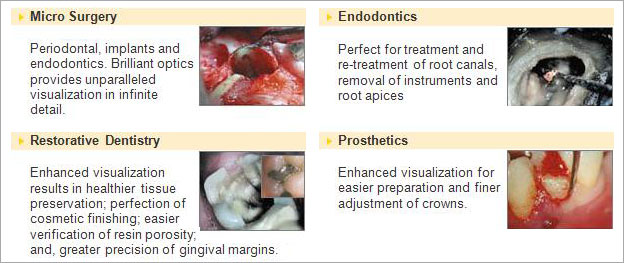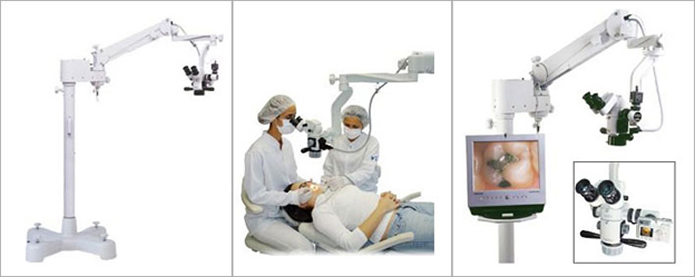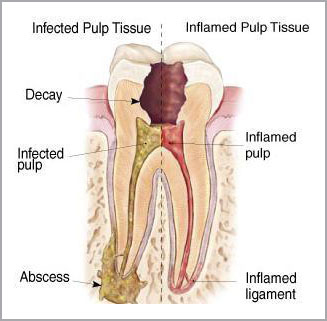Microscopic Endo
What is endodontic treatment?
"Endo" is the Greek word for "inside" and "odont" is Greek for "tooth." Endodontic treatment treats the inside of the tooth. The aim of root canal treatment is to get rid of the damaged pulp and the bacteria that are causing theinfection. Devoted professionalism and beyond...

Why Would You Need Root Canal Treatment?
Root canal treatment is needed for two main reasons.
- The first is infection. An untreated cavity is a common cause of pulp infection. The decay erodes the enamel and dentin of the tooth until it reaches a root canal. This allows bacteria to infect the pulp. Antibiotics can't get to infections inside teeth. The inflammation caused by the infection reduces the blood supply to the tooth. The reduced blood supply also keeps the pulp from healing.
- The second reason for a root canal treatment is damage to the pulp that can't be fixed. Trauma or a fractured tooth can damage the pulp. So can a lot of restoration, such as several fillings placed in the same tooth over a period of time. Sometimes, common dental procedures, such as preparing a tooth for a crown, can hurt the pulp. Then the tooth might need a root canal.
When the pulp is inflamed but not infected, it may heal on its own. Your dentist may want see if this will happen before doing root canal treatment. If the pulp remains inflamed, it can be painful and may lead to infection.
An infection in the pulp can affect the bone around the tooth. This can cause an abscess to form. The goal of root canal treatment is to save the tooth by removing the infected or damaged pulp, treating any infection, and filling the empty root canals with a material called gutta percha.
If root canal treatment is not done, an infected tooth may have to be extracted. It is better to keep your natural teeth if you can. If a tooth is missing, neighboring teeth can drift out of line. They also can be overstressed from chewing. Keeping your natural teeth also helps you to avoid other treatments, such as implants or bridges. Also, if you ignore an infected or injured tooth the infection can spread to other parts of your body.
Having root canal treatment on a tooth does not mean that the tooth will need to be pulled out in a few years. Once a tooth is treated, it almost always will last the rest of your life.
Signs and Symptoms
If you have an infection of the pulp, you may not feel any pain at first. But if it is not treated, the infection will cause pain and swelling. In some cases, an abscess will form.
Your tooth might need a root canal if:
- It hurts when you bite down on it, touch it or push on it
- It is sensitive to heat
- It is sensitive to cold for more than a couple of seconds
- There is swelling near the tooth
- It is discolored (whether it hurts or not)
- It is broken
- Sometimes, however, there are no symptoms.
To determine whether your tooth needs root canal treatment, your dentist will often place hot or cold substances against the tooth. The purpose is to see if it is more or less sensitive than a normal tooth. He or she will examine the tissues around the tooth and gently tap on the tooth to test for symptoms.
You also will be given X-rays of the bone around the tooth. The X-rays may show a widening of the ligament that holds the tooth in place or a dark spot at the tip of the root. If either of these is present, your dentist probably will recommend a root canal procedure.
Your dentist may need more information about the tooth. He or she may use an electric pulp tester. This hand-held device sends a small electric current through the tooth. It helps your dentist decide whether the pulp is alive. This test does not cause pain or a shock. You may feel a tingling sensation. It will stop when the tester is removed from the tooth.
N.B: An electric pulp tester should not be used if you have a cardiac pacemaker.
How does endodontic treatment save the tooth?
The endodontist removes the inflamed or infected pulp, carefully cleans and shapes the inside of the canal, a channel inside the root, then fills and seals the space. Afterward, you will return to your dentist, who will place a crown or other restoration on the tooth to protect and restore it to full function. After restoration, the tooth continues to function like any other tooth.
Length of treatment:
Root canal treatment can be done in one or more visits. It depends on the situation. An uncomplicated root canal treatment often can be completed in one visit. Some teeth may be more difficult to treat because of where they are in the mouth. Some teeth have more roots than other teeth. Treating a tooth with many roots takes longer. Some teeth have curved root canals that are difficult to find. If you have an infection, you will visit the dentist several times so that he or she can make sure that the infection is gone.
Endodontic Procedure:
Endodontic treatment can often be performed in one or two visits and involves the following steps:
1. The endodontist examines and x-rays the tooth, then administers local anesthetic. After the tooth is numb, the endodontist places a small protective sheet called a "dental dam" over the area to isolate the tooth and keep it clean and free of saliva during the procedure.
2. The endodontist makes an opening in the crown of the tooth. Very small instruments are used to clean the pulp from the pulp chamber and root canals and to shape the space for filling.
The root canals have to be measured. Your dentist needs to know how long the canals are to make sure the entire canal is cleaned. He or she also needs to know how much filling material to put in the cleaned canals.
To measure the root canals, dentists use X-rays or an electric device called an apex locator. For an X-ray, your dentist will place a file into the canal and then take an X-ray. An apex locator measures a root canal based on its resistance to a small electric current. Many dentists use both methods.
Cleaning:
After the canals have been measured, your endodontist will use special tools to clean out all of the diseased pulp. Then the canal is cleaned with antiseptic. This helps treat and prevent infection. All the canals within a tooth must be cleaned. Teeth have different numbers of canals:
- The top front teeth have one canal.
- The bottom front teeth have one or two canals.
- The premolars have one or two canals.
- The molars have three or four canals.
Will I feel pain during or after the procedure?
Many endodontic procedures are performed to relieve the pain of toothaches caused by pulp inflammation or infection. With modern techniques and anesthetics, most patients report that they are comfortable during the procedure.
Your tooth may be sore for two to three days after the procedure. The worse the infection and inflammation were, the more sensitive the tooth will be after treatment. Avoid chewing on the affected side. You can take over-the-counter pain relievers. A pain reliever that also reduces inflammation is likely to be most helpful. Examples include ibuprofen and aspirin.
Your tooth may continue to feel slightly different from your other teeth for some time after your endodontic treatment is completed. However, if you have severe pain or pressure or pain that lasts more than a few days, call your Endodontist.

